Giovanni Virginio Schiaparelli (14 March 1835 – 4 July 1910) was an Italian astronomer and science historian, best known for his work in planetary astronomy. Schiaparelli gained fame for his detailed observations of Mars, which led to the identification of what he initially described as “canali” (channels or grooves) on the planet’s surface. While the term was later misinterpreted as evidence of artificial canals, Schiaparelli’s observations were important in advancing the study of Mars.
Introduction
Giovanni Schiaparelli was one of the most influential astronomers of the 19th century. His groundbreaking work on Mars, particularly his observations of “canali” (which later sparked the myth of Martian canals), has left a profound mark on both astronomy and science fiction. In this article, we’ll explore Schiaparelli’s life, his major contributions, and how his work continues to shape the field of astronomy today.
The Early Life of Giovanni Schiaparelli
Born on March 14, 1835, in the small town of Savigliano, Italy, Giovanni Schiaparelli showed early signs of a keen interest in science and mathematics. Schiaparelli was raised in a family of modest means but had the privilege of studying at the University of Turin, where his interest in astronomy flourished.
- Academic Pursuits: Schiaparelli was drawn to the natural sciences, particularly physics and astronomy, which led him to work at the Brera Observatory in Milan in 1860. His career began to take shape during this period, where his skill in using telescopes for astronomical observations was honed.
- Contribution to the Italian Scientific Community: Schiaparelli’s early work focused on calculating the orbits of asteroids and comets. His reputation grew steadily within the Italian scientific community, and by the late 1860s, Schiaparelli was regarded as one of the foremost astronomers in Italy.
Schiaparelli and the Planet Mars
Giovanni Schiaparelli’s most famous contributions to astronomy came from his observations of the planet Mars. Between 1877 and 1878, he conducted extensive studies of the Martian surface, using a telescope to map the planet like never before.
- The Canali Controversy: Schiaparelli’s most famous (and controversial) observation was the “canali” he reported on Mars. The word “canali” in Italian translates to “channels” in English, but it was mistakenly interpreted as “canals.” This led to widespread speculation that Mars was home to intelligent life capable of constructing massive canals.
- Schiaparelli’s Mars Map: Schiaparelli’s detailed map of Mars, created in 1888, was one of the most comprehensive astronomical maps at the time. His map depicted the planet’s surface features with great accuracy, including dark markings and bright polar caps that would later be confirmed by spacecraft missions.
Schiaparelli’s Impact on Modern Astronomy
Giovanni Schiaparelli’s work on Mars was groundbreaking, but his contributions to astronomy go far beyond this one planet.
- Studies of Comets and Asteroids: Schiaparelli also made significant contributions to the study of comets and asteroids. He was one of the first astronomers to identify the relationship between comets and meteor showers. His observations helped lay the groundwork for later studies on the origins of meteor showers.
- Director of the Brera Observatory: Schiaparelli served as the director of the Brera Observatory in Milan from 1862 until his death in 1910. During his time there, he expanded the observatory’s resources and research programs, helping to cement Italy’s place in the global scientific community.
Giovanni Schiaparelli’s Influence on Popular Culture
While Schiaparelli’s work was rooted in hard science, his observations of Mars sparked the imagination of writers and artists, blending the line between science and science fiction.
- Influence on H.G. Wells and Other Writers: The idea of Martian canals influenced famous science fiction authors, including H.G. Wells, whose novel The War of the Worlds imagined a Martian civilization using canals for transportation. Schiaparelli’s observations, though later proven to be misinterpreted, played a significant role in the popular portrayal of Mars as a habitable world.
- Cultural Legacy: Schiaparelli’s discoveries continue to inspire popular media, from books and films to space exploration missions. The ongoing search for life on Mars and the mapping of its surface are direct results of Schiaparelli’s pioneering work.
Key Discoveries and Achievements
- Mars Mapping: Schiaparelli’s comprehensive maps of Mars set the stage for future Martian exploration.
- Comet and Asteroid Studies: His research into the behavior of comets and asteroids greatly advanced our understanding of these celestial bodies.
- Brera Observatory Leadership: His leadership at the Brera Observatory helped shape Italy’s prominence in the field of astronomy.
FAQ: Giovanni Schiaparelli
Q1: What did Giovanni Schiaparelli discover about Mars?
Schiaparelli is best known for mapping the surface of Mars and observing “canali,” which were later misinterpreted as artificial canals. His detailed maps were some of the first to provide an in-depth look at the Martian landscape.
Q2: Did Schiaparelli believe in life on Mars?
While Schiaparelli didn’t directly claim that life existed on Mars, his discovery of the “canals” led many to believe that Mars might be inhabited by intelligent beings.
Q3: How did Schiaparelli impact modern astronomy?
Schiaparelli’s contributions to the study of Mars, comets, and asteroids were foundational to the development of modern astronomy. His work paved the way for future missions to explore Mars and other celestial bodies.
Wrapping Up
Giovanni Schiaparelli was more than just an astronomer; he was a pioneer whose work bridged the gap between science and imagination. His contributions continue to influence both scientific inquiry and popular culture. From mapping Mars to studying asteroids, Schiaparelli’s legacy lives on in every new discovery we make about the cosmos. As we continue to explore space, we owe much of our understanding of the universe to his groundbreaking work.




